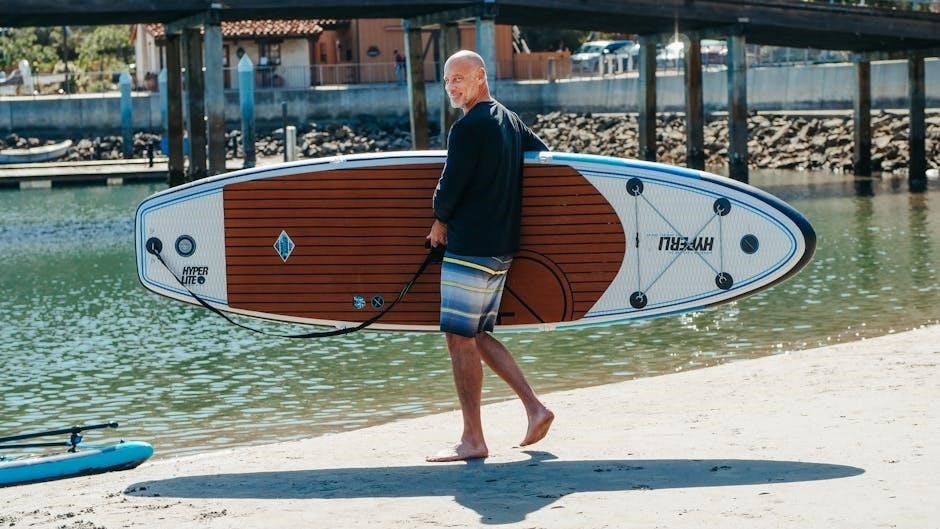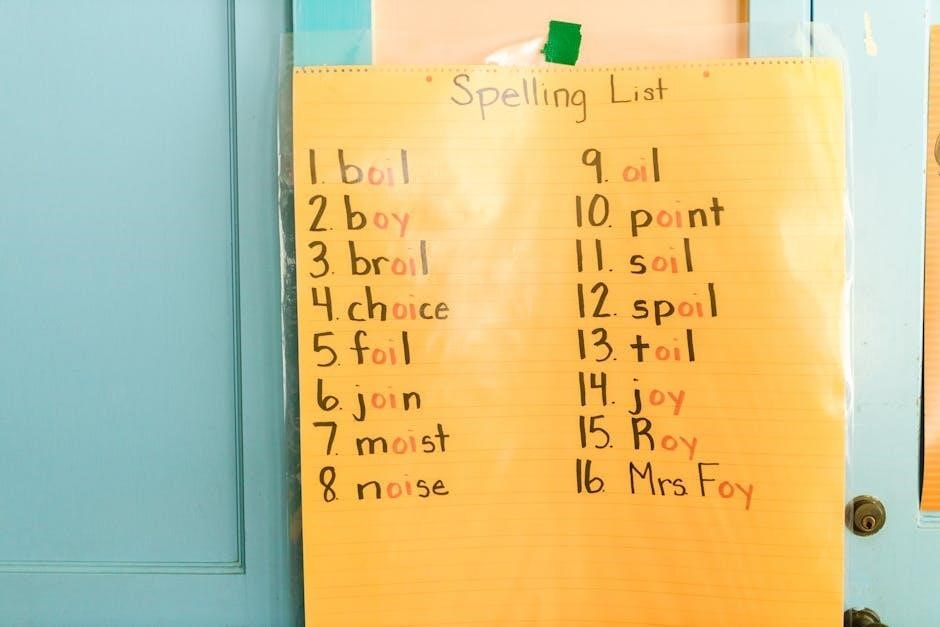Selecting the right SUP board size is crucial for optimal performance and comfort. This guide helps you understand how to choose a board based on your weight, skill level, and paddling goals, ensuring a perfect match for your adventures on the water.
What is a Stand-Up Paddleboard (SUP)?
A Stand-Up Paddleboard (SUP) is a large, buoyant board resembling a surfboard, designed for standing and paddling with a single oar. Typically made of lightweight materials like foam, fiberglass, or carbon fiber, SUP boards vary in length, width, and thickness to suit different paddlers and activities. They are used for recreation, fitness, racing, surfing, and even fishing. The design allows users to stand upright and propel themselves through calm or choppy waters, offering a full-body workout while enjoying nature. SUPs are versatile, catering to beginners and experienced paddlers alike, making them a popular choice for water enthusiasts worldwide.
Why is Choosing the Right SUP Board Size Important?
Choosing the right SUP board size is essential for stability, maneuverability, and overall performance. A board that is too small may lack stability, while one that is too large can be difficult to handle. The right size ensures optimal buoyancy, supporting your weight effectively. It also enhances your paddling efficiency, allowing you to glide smoothly through the water. Proper sizing improves balance, making it easier to stand and maneuver, especially for beginners. Additionally, it ensures the board suits your intended use, whether for recreation, racing, or surfing. A well-fitted SUP board boosts confidence and enhances your overall paddling experience.

Understanding the Factors Influencing SUP Board Size
Paddler weight, skill level, and intended use are key factors influencing SUP board size. Proper sizing ensures stability, performance, and efficiency, making your paddling experience enjoyable and effective.
Height and Weight of the Paddler
Your height and weight significantly impact the choice of SUP board size. Taller paddlers may prefer longer boards for stability, while shorter paddlers might find shorter boards more manageable. Weight plays a crucial role in determining buoyancy and overall performance. A board that is too small for your weight may feel unstable, while a board that is too large might be difficult to maneuver. The volume of the board, measured in liters, should match your weight to ensure proper flotation. Additionally, the width of the board affects stability, with wider boards offering more balance for heavier paddlers. Matching your height and weight to the right board size ensures optimal performance and comfort on the water.
Skill Level: Beginner, Intermediate, or Advanced
Skill Level: Beginner, Intermediate, or Advanced
Your skill level is a key factor in selecting the right SUP board. Beginners benefit from wider, thicker boards with higher volume, offering greater stability and buoyancy. These features help new paddlers build confidence and balance. Intermediate paddlers can transition to slightly narrower boards, allowing for better maneuverability while maintaining stability. Advanced paddlers often prefer performance-oriented boards with less volume and a narrower width, enabling quicker turns and higher speeds. The skill level determines the balance between stability and performance, ensuring the board meets your needs as you progress in your SUP journey.
Purpose of Use: Recreation, Racing, Surfing, or Fishing
The intended use of your SUP board greatly influences its ideal size and design. Recreational paddlers benefit from versatile, all-around boards with medium length and width, offering stability and ease of use. Racing requires narrower, longer boards for speed and efficiency, while surfing demands shorter, more maneuverable boards for quick turns. Fishing needs stable, wide boards with ample space for gear. Understanding your primary use ensures the board is tailored to your activities, enhancing performance and enjoyment. Whether cruising, competing, catching waves, or reeling in fish, the right size and shape make all the difference in your paddling experience.
SUP Board Size Chart

A SUP board size chart helps determine the ideal dimensions based on your weight, skill level, and paddling style. It considers length, width, thickness, and volume to ensure optimal performance, stability, and maneuverability for your specific needs.
Length: How to Choose the Right Measurement
The length of a SUP board significantly impacts performance and stability. Longer boards (12-14 feet) are ideal for racing, touring, or calm waters, offering speed and glide. Shorter boards (8-10 feet) are better for surfing, yoga, or maneuverability in tight spaces. For all-around use, a medium length (10-12 feet) balances stability and versatility. Consider your weight, skill level, and paddling style when selecting. Lighter paddlers may prefer shorter boards for ease of handling, while heavier riders benefit from longer boards for stability. Test different lengths to find the perfect fit for your needs and paddling environment.
Width: Finding the Perfect Balance
The width of a SUP board plays a crucial role in stability and maneuverability. Wider boards (32-36 inches) provide greater stability, making them ideal for beginners, fishing, or yoga. Narrower boards (30-32 inches) offer better speed and performance, suited for racing or experienced paddlers. The optimal width depends on your skill level, weight, and intended use. A wider board may feel more stable but could limit agility, while a narrower board enhances glide but requires better balance. Consider your paddling style and the water conditions you’ll encounter to find the perfect width for your SUP adventures and ensure a balanced, enjoyable experience.
Thickness: Understanding Its Impact on Stability
The thickness of a SUP board significantly impacts its stability and buoyancy. Thicker boards (4.5-5 inches) are more buoyant, offering greater stability, which is ideal for heavier paddlers or those seeking a stable platform for activities like fishing or yoga. Thinner boards (4-4.5 inches) are lighter and more maneuverable, appealing to experienced paddlers who prioritize performance over stability. The right thickness ensures optimal floatation and control, balancing the needs of your weight and skill level. A thicker board provides added confidence for beginners, while a thinner profile enhances speed and agility for advanced users, ensuring a seamless connection between you and the water.

How to Choose the Right SUP Board Size for You
Assess your needs by considering your weight, skill level, and paddling style. Match your size to the board’s volume for optimal buoyancy and stability. Test paddle

Determining Your Ideal Volume Based on Weight
Your ideal SUP board volume is directly linked to your weight and skill level. A general rule is to multiply your weight (in kilograms) by a factor ranging from 1.5 to 3.5, depending on your experience. Beginners should opt for higher volume (closer to 3.5) for stability, while advanced paddlers can choose lower volume for better performance. Lighter paddlers may prefer smaller boards, while heavier individuals require more buoyancy. Ensure the board’s volume matches your needs for optimal stability and maneuverability. Proper volume ensures the board floats well and responds smoothly to your movements on the water.
Matching Board Size to Your Paddling Style
Your paddling style significantly influences the ideal SUP board size. Recreational paddlers who prioritize stability and ease of use often prefer slightly longer and wider boards. Touring or distance paddlers benefit from longer, narrower boards for efficiency and speed. If you’re into racing, a sleek, lightweight board with minimal width is best for performance. For surfing, shorter, more maneuverable boards are ideal. Consider how you’ll use your board most often and align its size with your paddling goals for optimal performance and enjoyment on the water.
Considering the Water Conditions You’ll Paddle In
Water conditions play a crucial role in selecting the right SUP board size. In calm or flat waters, a longer, narrower board can enhance speed and efficiency. For choppy or rough waters, a shorter, wider board with more volume provides stability and control. If you’ll be paddling in the ocean with waves, a shorter, more maneuverable board is ideal for surfing and turning. Always consider where you’ll paddle most often, as board size and shape will impact performance in different water environments. Matching your board to the conditions ensures a safer and more enjoyable experience on the water.

Common Mistakes to Avoid When Selecting a SUP Board
Common mistakes include choosing a board too small for your weight, ignoring width and thickness, and not considering your paddling style or intended use.

Choosing a Board Too Small for Your Weight
Choosing a SUP board that is too small for your weight can significantly compromise stability and performance. A board that is undersized may sink too low in the water, making it difficult to paddle efficiently and maintain balance. This can lead to poor tracking, reduced buoyancy, and increased fatigue. Additionally, a smaller board may cause the nose to submerge, making it harder to control, especially in choppy conditions. Always ensure the board’s volume matches your weight to avoid these issues and enjoy a more comfortable, enjoyable paddling experience.
Overlooking the Importance of Width and Thickness

Width and thickness are critical factors in determining a SUP board’s stability and performance. A board with insufficient width may lack stability, making it difficult to balance, especially for beginners. Similarly, a board that is too thin may lack buoyancy and rigidity, affecting its overall performance. Ignoring these dimensions can lead to a less enjoyable paddling experience, poor tracking, and increased fatigue. Always consider both width and thickness alongside length to ensure the board meets your needs for stability, maneuverability, and efficiency in the water. These dimensions are just as important as volume when selecting the right SUP board for you.
SUP Board Size for Specific Activities
Sup boards vary in size based on activity. Racing boards are longer for speed, while surfing boards are shorter for maneuverability. Fishing boards prioritize stability and space.
Best Sizes for Racing and Performance
For racing and performance, SUP boards are designed for speed and efficiency. Optimal lengths range from 12 to 14 feet, with widths between 24 to 27 inches. A narrower width reduces drag, while a rounded nose enhances glide. Thickness should be 5 to 6 inches for buoyancy and stability at high speeds. Lighter materials like carbon fiber are recommended for better acceleration. Ensure the board’s volume matches your weight for optimal performance. These dimensions provide the perfect balance of speed, maneuverability, and control, making them ideal for competitive paddlers seeking peak performance.
Optimal Sizes for Surfing and Maneuverability
For surfing and maneuverability, SUP boards are shorter and more agile. Ideal lengths range from 8 to 10 feet, with widths between 28 to 32 inches. A shorter board allows for tighter turns and better wave responsiveness. Thickness should be around 4 to 5 inches for optimal buoyancy and stability in the surf. A rounded nose shape enhances performance in waves, while a squared-off tail improves control. Lighter materials and a lower volume (around 100-150 liters) are preferred for quicker reactions and easier handling. These dimensions ensure a balance of stability, agility, and responsiveness for catching and riding waves effectively.
Recommended Sizes for Fishing and Stability
Fishing on a SUP requires a stable and durable board. Optimal lengths range from 10 to 12 feet, providing ample space for gear. Widths should be 32 to 40 inches for enhanced stability, allowing anglers to stand and move without tipping. Thickness of 5 to 6 inches ensures buoyancy, supporting the weight of gear and passengers. A flat, wide deck is ideal for fishing equipment, while a displacement hull improves tracking. Higher volume (200-300 liters) enhances stability in calm or choppy waters. These dimensions create a sturdy, reliable platform for fishing adventures.

Final Tips for Buying the Perfect SUP Board
- Always test paddle before purchasing to ensure comfort and performance.
- Consult experts or read reviews to make an informed decision.
Trying Before Buying: The Importance of a Test Paddle
A test paddle is essential to ensure the SUP board suits your needs; It allows you to assess comfort, stability, and performance in real conditions. By experiencing how the board handles, you can determine if it matches your skill level and paddling style. Testing also helps you evaluate tracking, maneuverability, and how it responds to your weight and movement. This hands-on experience ensures you make the right choice, avoiding costly mistakes. Always prioritize a test paddle before committing to a purchase for the best fit and enjoyment on the water.
Consulting with Experts or Online Reviews
Consulting with experts or reading online reviews is a valuable step in choosing the right SUP board. Experts can provide personalized recommendations based on your skill level, weight, and intended use. Online reviews offer insights from real users, highlighting pros, cons, and performance in various conditions. Pay attention to feedback about stability, durability, and how the board handles different paddling styles. Trustworthy reviews can help you narrow down options and avoid costly mistakes. Combine expert advice with real user experiences to make an informed decision and find the perfect SUP board for your needs and preferences.

Recap of Key Points for Choosing the Right SUP Board Size
Choosing the right SUP board size involves balancing volume, length, width, and thickness. Consider your weight, skill level, and intended use to ensure stability and performance. For beginners, stability is key, while advanced paddlers may prioritize maneuverability. Volume should match your weight for optimal buoyancy. Test paddling helps confirm the right fit. Avoid sizing errors by not overlooking width and thickness. Match your board to water conditions and activity type, whether racing, surfing, or fishing. Proper sizing enhances your SUP experience, making it safer and more enjoyable. Always test before buying and seek expert advice if unsure.
Encouragement to Start Your SUP Journey
Embarking on your SUP journey is an exciting adventure! With the right board size, you’ll gain confidence and control on the water. Whether cruising calmly or challenging yourself with new techniques, SUP offers a unique way to connect with nature and improve fitness. Don’t be afraid to start small—beginners can master the basics quickly. Embrace the journey, enjoy the serenity of paddling, and let the thrill of exploring new waters inspire you. Remember, every stroke brings you closer to discovering the joy and freedom of stand-up paddleboarding. Dive in, stay curious, and make every paddle a memorable experience!
